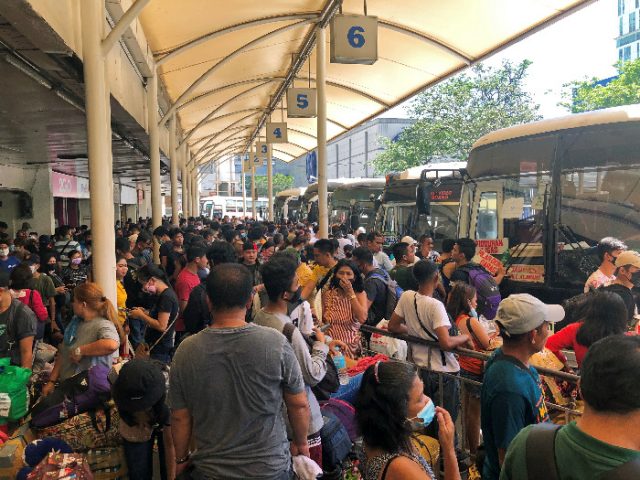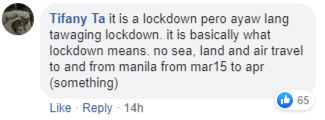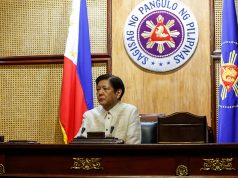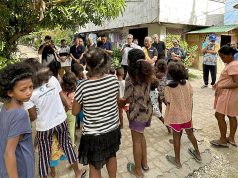
President Rodrigo Duterte yesterday declared a 30-day quarantine as he raised Code Red Sublevel 2 over Metro Manila, entailing restrictions on movement that are likened to a lockdown over the urbanized and populous region.
This decision came as part of the government’s measures to prevent the further spread of COVID-19, which has so far caused five deaths and 47 other confirmed cases in the country.
Part of the heightened alert is the tightened restriction of all land, domestic air and sea travel to and from Metro Manila for 30 days starting from March 15 to April 14, 2020.
Interior and Local Government Secretary Eduardo Año addressed concerns on affected workers who live in the Greater Manila Area, which are provinces in the outskirts of the capital such as Bulacan, Rizal and Cavite.
They are still allowed to enter and work in the capital provided that they present their company IDs as proof to authorities in designated checkpoints to enter and work there.
“Papayagan ‘yong mga magtatrabaho na pumasok provided lang na mayroon lang silang ID. Mayroon lang magpapatunay na ang work nila ay dito sa Metro Manila,” Año told radio DZMM.
Duterte assured the public that the provisions in this resolution will be subjected to daily case-to-case assessment by the Inter-Agency Task Force for the Management of Emerging Infectious Diseases.
This body is tasked to handle and control the spread of emerging infectious diseases such as COVID-19 in the country.
Lockdown and community quarantine
While the term “lockdown” was not used to describe the situation, some local news organizations used it in their reports, quoting the president, who himself acknowledged that while his staff refused to use the term, it is actually a lockdown.
“We do not want to use that (term). But it is a lockdown,” Duterte said in a televised announcement last night.
This triggered more questions.
Prior to the press briefing, there were also copies of a resolution about an imminent lockdown making rounds on social media.

Lockdown refers to “an emergency measure or condition in which people are temporarily prevented from entering or leaving a restricted area or building (such as a school) during a threat of danger.”
It is often used in schools, hospitals, and other communal places as protocols to keep them safe against bomb threats, active shooting and other types of crises.
Lockdown is also usually associated with prisoners, DILG spokesperson Jonathan Malaya said, because it means people are confined in one area only and not allowed to leave.
Quarantine, meanwhile, is the word often used to contain contagious medical illnesses.
Merriam-Webster said quarantine is “a restraint upon the activities or communication of persons or the transport of goods designed to prevent the spread of disease or pests.”
In Metro Manila’s case, the so-called community quarantine or at least region-wide quarantine is considered a softer or lenient form of lockdown.
Duterte himself also considered this lockdown in a sense.
“Ayaw namin gamitin ‘yan pero…kasi takot kayo sabihin ‘lockdown.’ And a…but it’s a lockdown. There is no struggle of power here,” the transcription of his speech read.
Part of the statement on Code Red Sublevel 2 read:
“To be clear, and to allay the fears and apprehension of the public, the government is essentially calling for a stricter implementation of preventive measures in order to slow down and put a halt to the further spread of COVID-19. While a total and absolute lockdown is considered by some as a valid preventive measure, current circumstances do not warrant such an extreme course of action.”
Several countries have already their own versions of a lockdown. These include Denmark, Ireland, Scandinavia, Italy and the city of Wuhan in China, where the outbreak started.
Other questions raised on social media
Even if Metro Manila workers living in nearby provinces are allowed to enter, another concern was raised online: How capable are authorities in screening thousands of workers coming in from nearby provinces on a daily basis during the quarantine period.
Critic Professional Heckler projected it would be “a next level carmaggedon.”
Ipakita lang daw sa checkpoint ang office/company ID ng mga nagmula sa adjacent provinces, allowed naman daw to enter NCR. Sa dami ng motorista at pasaherong sakay sa bus, kotse, van, cab, truck, jeep, etc., paano mo ichi-check 'yan? Carmageddon to the next level.
— The Professional Heckler (@hecklerforever8) March 13, 2020
GMA reporter Atom Araullo said this might be a “nightmare,” citing the nearly 15 million Filipinos who go to work in the morning.
Population in Metro Manila is estimated at 12M but swells to around 15M during the daytime because of all the people coming in from nearby provinces. If they are checked for identification one by one at checkpoints, that would be some kind of a nightmare. https://t.co/AmxYBptcd4
— Atom Araullo (@atomaraullo) March 12, 2020
Duterte only mentioned specific instructions for government employees. Work-from-home arrangements are only “encouraged” in the private sector, rather than enforced.
“Ito namang flexible work arrangement shall likewise be encouraged in the private sector,” Duterte said.









